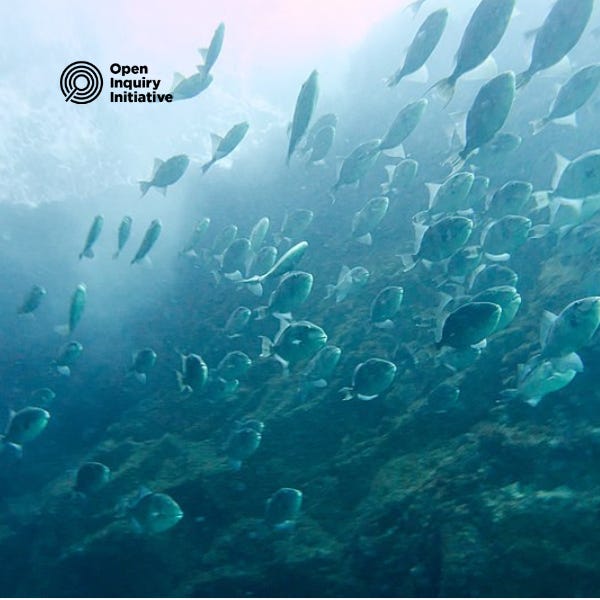|
 |
Collective Intelligence: Lessons From Fish, Friends, Family and ‘Animal Farm’
Social wisdom frees us from the need to know
In the first part of this two-part series, I argued that there is value in ignorance and that we shouldn’t force our educational ideals on our kids. Of course, after publishing that, I immediately coerced my daughter into reading about stoicism. I wasn’t sure how else to instill virtues like resilience, courage and discipline in her. When I started this piece her resistance had already grown strong, and her escape tactics (paradoxical questioning, subversion and diversion) were exceeding my best efforts to keep her on task. She had even resorted to intentionally mispronouncing Epictetus as “Asparagus.” I had already agreed to write about collective intelligence, a form of knowledge gained through group collaboration and consensus. Still, I felt like an uninformed hypocrite whose kid thinks philosophy is a joke.
One Sunday night I was trying to squeeze some reading in before my weekly roller-skating session when she tried the “Asparagus” trick, renaming Cleanthes “Kleenex” and citing sudden-onset, self-diagnosed dyslexia. When that didn’t work, she appealed to my guilty conscience: “Can’t we read ‘Animal Farm’ instead?” We’d started reading the Orwellian satire a few years ago and never finished, so I said we would—after we finished this book. She read on, continuing her tactics until, conceding defeat, I finally stormed out to skate.
Communal Meditations
I used to skate alone to declutter my mind, but since moving to Nashville, home of some extraordinary skaters, I’m drawn to a more social meditation. That night a friend asked me to partner skate, but there’s a vulnerability in partner skating that means I am often reluctant. It requires letting someone else lead, which means giving up physical and mental assumptions. After months of not skating with this partner, I finally figured out the move he had been patiently waiting for me to grasp. “You’ve been practicing!” Had I? I hadn’t “practiced” in years, thinking back to my solo tennis court sessions. How had I learned the move without repeated solo practice?
The following morning, my mind, usually clear after skating, was more like a palimpsest, marked by the previous night's interactions. I settled into the London Writer’s Salon’s silent writing hour to start on this essay that I’d been avoiding because, after months of study, I still did not feel like I knew enough about collective intelligence to write about it. As 150+ faces populated the Zoom room, we all set intentions for the hour. Assimilating to the behaviors of the group, I turned on my camera for accountability, listened to a host read an inspirational quote, raised my mug to “writing in community” and set off to follow Neil Gaiman’s rule of writing or doing nothing. Unthinking, my hands found the keyboard and started putting one word after another until traces of collective intelligence began to emerge.
The first thing I noticed was that assimilating behaviors from a group can lead individuals to produce something bigger than they could do in isolation. I saw this firsthand, not only in my writing group but also last summer, when I found myself at the Santa Fe Institute’s symposium on harnessing collective intelligence. The conference highlighted interdisciplinary work by computer scientists, artists and entrepreneurs, and the organizers and attendees seemed perfectly fine admitting that the goal was to explore the idea of collective intelligence. We spent an entire session just brainstorming, and even those who had studied collective behaviors and intelligent systems for years seemed to be open to feedback and interpretation.
One of those people, Iain Couzin, director of the Max Planck Institute of Animal Behavior, presented striking findings on the ways a variety of biological systems share information, from multicellular placozoa to human beings. Searching my notes from Couzin’s talk, I extrapolated his experiments to my own struggles—something that I wouldn’t normally do, but conducting myself as I would have at the conference, I let my mind draw speculative connections.
Fishing for Connections
Couzin’s lab measured how individuals in schools of fish have both internal goals and goals that pertain to social assimilation. Fish in close proximity react to changes in physical distance: When the distance between a leading fish and its follower increases, the follower accelerates to reduce the gap, the distance between the two snapping back in place like an elastic band. The geometry of Couzin’s fish reminded me how my skate partner physically pulled me into position and how I had to be relatively uninformed (and unconcerned) about our direction. I had to go with the flow. My mental and physical flexibility had improved by simply being in proximity to skaters who knew where to go and how to move. My daughter and I, on the other hand, are pulling in opposite directions, both of us thinking we know what’s best.
Having the right balance of “uninformed” individuals in a group was critical in Couzin’s experiments. Couzin tested this theory, in humans this time, by inserting varying numbers of individuals who were informed as to the location of the exits in a crowded football stadium. If there were too many people who knew where to go, the crowd counterintuitively took longer to exit. Looking up from my keyboard, I realized I was currently in a crowd. We weren’t exiting a stadium but writing in silence, together. If too many or too few of us were trying to lead the session, the group would be less productive.
Contrary to what we all want to think, sometimes ignorance is more than bliss—it’s necessary. In the case of my headstrong preteen, because I was so busy trying to lead her, I hadn’t really recognized she was exercising some of the very qualities I sought to teach her. Each retort was a creative, courageous attempt at changing the direction we were headed, but just like in skating, I was being resistant to letting someone else steer.
Human decisions are typically more complex than a fish’s decision to go left or right, but it’s possible that we share similar frameworks for these decisions. Schools of fish rely on many “bifurcations” to create breathtaking patterns that make the school look like one giant organism. Because of the huge number of decisions made, in theory, it should all work out over a collective average. If many binary decisions between left and right create large-scale movements for fish, I could imagine the same for us: Read or skate? Write or do nothing? Each binary choice is a tiny curve in the overall shape and path of our lives.
Further, individuals become highly sensitive to influence as they get closer to having to choose. Recalling how my sensitivity to my daughter’s antics grew as the clock ticked closer to skating time, I realized that perhaps she wasn’t ready for “Animal Farm” when we started it, but now she was, and maybe someday she’d be ready for old Asparagus and company, too. My timing was off, but each decision I’ve made has contributed to where she is. I have to have faith that she’ll continue to grow into an adult who will be able to navigate her own complex decisions in due time. And when she makes a mistake, it’ll be just one tiny fork in the grand scheme of her life.
Failure Is an Option
The fatalism of modern society makes our mistakes seem catastrophic, but in evolution, failure is a catalyst for adaptation. What’s even more interesting is that we’re not birds who must instinctively push our young out of the nest, and we’re not fish who have to school together in large groups. If my daughter makes a mistake, I can choose to try to help her adapt, and I have access to information about past failures that might apply to current circumstances.
For example, in the late 19th century, French sociologist Émile Durkheim thought we had failed at maintaining social norms and that this failure would lead to “anomie,” isolation and loneliness. Loneliness is now considered a rising epidemic in the U.S., but if Durkheim was right, we needn’t look too far to rediscover social norms: Nature provides norms that we can test and apply where we see fit. The loneliness epidemic could be an opportunity to grow our communities, and we can glean insights from our emerging digital connections to shed light on what we seem to desire.
Because we have access to a wide variety of social groups and models from which we can learn, fitting the right model to the right context is critical. Modeling and practice appear to be required for most aspects of learning. But I was expecting my daughter to exhibit discipline even though I was modeling questioning, dialogue and creativity. If I want her to learn discipline, I should probably model consistency and finish a book. Letting her finish “Animal Farm” might make it easier for her to practice discipline and avoid sparring matches that, while they might be preparing her for law school, ultimately make things less than ideal around the house.
“All happy families are alike; each unhappy family is unhappy in its own way.” Tolstoy’s famous opening line, known as the “Anna Karenina” principle, is seen across ecology, evolution and other dynamical systems. It describes how the path to a goal (such as being a happy family) can be narrow and rigid at critical moments. Those steering the ship (such as a skating partner) ought to be expertly aware of these moments. They learn from repeated practice and tried-and-true principles that seem to give us hints about how to proceed in our decision-making. For example, there are lots of ways humans could cease to exist, but only a few in which the conditions are prime for our survival. Similarly, there are lots of ways I could have done the wrong thing with my daughter, but only a few that will achieve the desired outcome of instilling specific virtues in her.
Despite the occasional narrowness of the right path, being human means we can channel collective wisdom from the world around us to course-correct our failures. If we can do that, we have room to be uninformed, mistake-making hypocrites at times. In fact, some of us need to be those hypocrites in order to catalyze guidance-seeking that will solve the next set of problems, whatever they may be. When we learn from nature, our families and each other, we don’t need to be the best or the most informed or have read all the right books—although I hear Orwell wrote a good one. We should simply learn how to learn from the world around us, moving by trial and error, having faith that we can find a balance of ignorance and intelligence that will allow us to keep swimming along.
You’re currently a free subscriber to Discourse .

